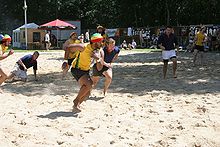| Competition | Teams | Countries | Average Attendance |
|---|---|---|---|
| Super Rugby | 18 | South Africa (6), New Zealand (5), Australia (5), Argentina (1), Japan (1) |
20,384 |
| Premiership | 12 | England | 13,354 |
| Top 14 | 14 | France | 13,207 |
| Currie Cup | 9 | South Africa | 11,125 |
| Pro12 | 12 | Ireland (4), Wales (4), Scotland (2), Italy (2) |
8,586 |
| Mitre 10 Cup | 14 | New Zealand | 7,203 |
| Top League | 16 | Japan | 4,872 |
| Rugby Pro D2 | 16 | France | 4,222 |
| RFU Championship | 12 | England | 2,738 |
| NRC | 8 | Australia | 1,450 |
| Professional Rugby League | 10 | Russia | |
| SuperLiga | 7 | Romania |
Variants
Main article: Rugby sevens
Beach rugby match
Major tournaments include the Hong Kong Sevens and Dubai Sevens, both held in areas not normally associated with the highest levels of the 15-a-side game. A more recent variant of the sport is Rugby tens (10's or Xs), a Malaysian variant with ten players per side.[170]
Due to the physical nature of playing rugby, several variants have been created to introduce the sport to children with a reduced level of physical contact.[171] Of these versions, Touch rugby, in which "tackles" are made by simply touching the ball carrier with two hands, is popular as a mixed sex version of the sport played by both children and adults.[172][173] Tag Rugby, is a version in which the participants wear a belt with two hook-and-loop fastener tags, the removal of either counting as a 'tackle'. Tag Rugby also varies in the fact that kicking the ball is not allowed.[174]
Mini rugby is another variant of rugby union aimed at fostering the sport in children.[175][176] It is played with only eight players and on a smaller pitch.[175] Similar to Tag Rugby, American Flag Rugby, (AFR), is a mixed gender, non-contact imitation of rugby union designed for American children entering grades K-9.[177] Both American Flag Rugby and Mini Rugby differ to Tag Rugby in that they introduce more advanced elements of rugby union as the participants age.[175]
Other less formal variants include beach rugby and snow rugby.[171][178]
Influence on other sports
See also: History of American football, Comparison of American football and rugby union, Origins of Australian rules football, Comparison of rugby league and rugby union, and History of rugby league
Australian football pioneer Tom Wills drew inspiration from an early version of rugby football he learnt whilst a pupil at Rugby School.
American football[179][180] and Canadian football[181] are derived from early forms of rugby.[181]
Australian rules football was influenced by rugby football and other games originating in English public schools.[182][183][184]
James Naismith took aspects of many sports including rugby to invent basketball.[185] The most obvious contribution is the jump ball's similarity to the line-out as well as the underhand shooting style that dominated the early years of the sport. Naismith played rugby at McGill University.[186]
Swedish football was a code whose rules were a mix of Association and Rugby football rules.[187][188]
Rugby lends its name to wheelchair rugby, a full contact sport which contains elements of rugby such as crossing a try line with the ball to score.[189]


No comments:
Post a Comment